Connecticut is home to a plethora of wild edible mushrooms throughout the state. Knowing which mushrooms to look for means that you can reap the benefits of harvesting wild food near your home and enjoy what nature has to offer. To kickstart your journey into familiarizing yourself with mushrooms in your local area, here are ten mushrooms that are commonly found in Connecticut!
Disclaimer
This article does not describe the details needed to thoroughly identify these mushrooms. Deadly and otherwise toxic look-a-likes do exist and may even be common in your area. Before foraging for any mushroom please spend the time to thoroughly Identify the mushroom using multiple sources.
Hen of the Woods (Grifola Frondosa)

Hen of the Woods is also known as Sheep’s Head mushroom or Ram’s Head mushroom. Hen of the Woods predominantly grows in older forests, at the base of oak trees mostly, and in northern climates near bodies of water. This mushroom is brown or grey with white edges, with flat or ruffled caps, reaching between four and 36 inches wide and two or three feet tall. They can even weigh up to 30 pounds! Autumn is the best time to forage Hen of the Woods.
Chicken of the Woods (Laetiporus sulphureus)
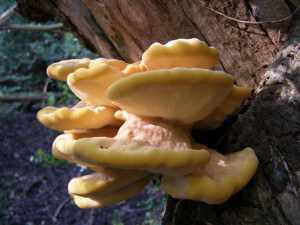
Chicken of the Woods is a particularly easy-to-spot mushroom in the wild, as this mushroom has a vibrant orange color. Chicken of the Woods is also known as Sulphur Shelf, as it resembles a shelf-like structure. However, Chicken of the Woods was named based on its texture and flavor, which has been described to resemble chicken meat. This mushroom often reaches two to 10 inches in width and can weigh over 100 pounds. It is most commonly found on decaying or dead oak trees and is best harvested from spring to autumn.
Winecap (Stropharia rugoso-annulata)
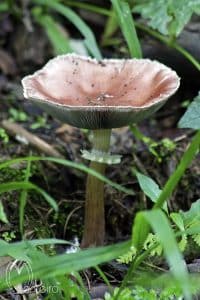
This luxuriously-named mushroom is named for its rich, burgundy color. Winecap is also known as Garden Giant mushroom. It is native to Europe and North America and has a burgundy top with grey gills and white flesh. The Winecap mushroom reaches an average height of eight inches and 12 inches in width. It grows most often from spring to autumn, particularly along streambeds. It’s important to remember that the mushroom cap flattens with age.
Wine Cap Mushroom: All about the King Stropharia Rugosoannulata (healing-mushrooms.net)
Oyster Mushroom (Pleurotus)
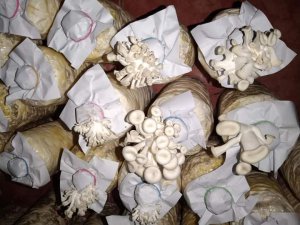
The Oyster mushroom is another variety of fungi named for its appearance, as the body resembles an oyster shell with decurrent gills that directly run from the stem. Oyster mushrooms range from white to light brown in color and often grow on deciduous hardwoods, including beech and aspen trees. The cap of this mushroom often reaches between two and 10 inches across in a shelf-like formation. It is also another type of saprotrophic mushroom, which grows from dying or dead trees commonly during the summer and fall seasons. Aside from appearance, oyster mushrooms often omit a mild anise odor, making it slightly easier to identify.
Golden Chanterelle (Cantherallus cibarius)
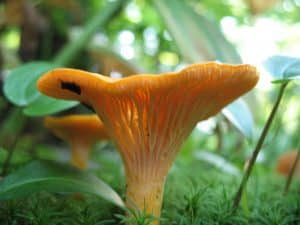
Another bold yellow-orange mushroom is the Golden Chanterelle. This funnel-shaped mushroom grows underneath live oak trees, sprouting from the soil alongside the trunk, from late June to early August. Golden Chanterelle mushrooms have a curved stalk and a smooth texture. The cap reaches between a half-inch and six inches, with the stalk averaging one to three inches tall. When searching for this mushroom, be aware of its poisonous lookalike, the Jack O Lantern mushroom, or the Omphalotus illudens.
Cinnabar Chanterelle (Cantherallus cinnabarinus)

The Cinnabar chanterelle mushroom is also called the Red Chanterelle mushroom, as it is a red fungus. Cinnabar chanterelle thrives in the summer and autumn seasons, growing on hardwood trees and from the soil surrounding the trees. Their peak growing time spans from late July to early August. These mushrooms have small caps that only reach ¼ to ½ inches with stalks that grow between ½ to 1 and a half inches tall. The cinnabar chanterelle also has a slightly fruity or piney flavor.
Black Trumpet (Craterellus cornucopioides)
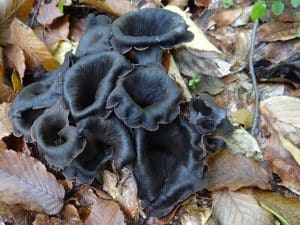
Black trumpet mushrooms are a common black fungus that grows in forests, sprouting from the soil. You will most commonly find the Black Trumpet mushroom alongside the trunk of an oak or beech tree. This mushroom grows in patches, so where you find a few mushrooms, there are sure to be more in the nearby area, forming in clusters that spread between three and 13 feet. Common places to find these patches include logging roadsides, moss patches, and steep banks between the months of June to September. There are no known similar lookalikes to this mushroom.
Turkey Tail (Coriolus or Polyporus versicolor)
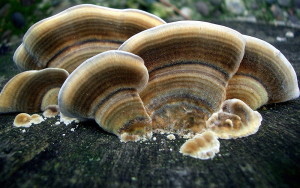
Turkey Tail is a common mushroom variety that is one of the easiest to identify in the wild, with the exception of one similar lookalike, which is called False Turkey Tail. Turkey tail mushrooms grow throughout most of the year, from May to December, on fallen hardwood trees, on either the logs or the stumps. Turkey tail mushrooms form in the shape of shelves or rosettes. Its cap spans between one to four inches in width and is a stemless variety. The underside of the Turkey Tail mushroom is white, and the fungi release spores from the pores instead of its gills.
Shaggy Mane (Coprinus comatus)
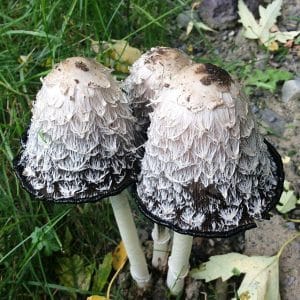
Shaggy Mane mushrooms are another easily identifiable mushroom. This mushroom is also known as the Lawyer’s Wig mushroom and the Inky Cap mushroom. This mushroom has three lookalikes, including the Ink Cap, Snowy Ink Cap, and Wooly Ink Cap mushrooms, and is also closely related to other inky cap mushroom varieties. The Shaggy Mane mushroom commonly grows on lawns and is a primarily white mushroom that resembles the powdered, white wigs that were once commonly associated with lawyers and judges. It is important to know that when foraging these mushrooms, they dissolve into a black residue even while fresh, and will gradually dissolve more with age. The gills are known for producing an ink-like residue, hence the name Inky Cap mushroom.
Giant Puffball (Calvatia gigantea)
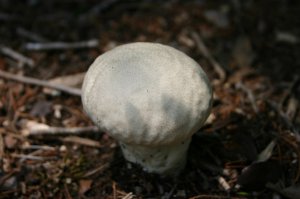
Puffball mushrooms are some of the most commonly thought of varieties when someone thinks of a mushroom, and the Giant Puffball is one common variety found in fields, meadows, and deciduous forests. These mushrooms can reach between four and 20 inches in size and weigh upward of over 40 points, developing only within a few weeks. The best time to search for the Giant Puffball mushroom is in the late summer and autumn seasons. Be cautious of its poisonous lookalike, the Earthball mushroom. The Giant Puffball mushroom is safe to eat when the inside is fully white, but take caution to avoid Young Deathcap mushrooms, which look similar on the outside, but have outlines of gills inside.
Pear-shaped Puffball (Apioperdon pyriforme)
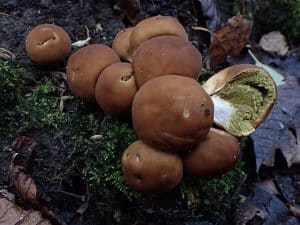
Another variety of Puffball mushrooms is the Pear-shaped Puffball, which received its name due to its pear-like coloring, which features a yellowish-brown exterior and a fully white interior. This variety of puffball grows in large clusters from July to November, growing primarily on decaying wood. This mushroom has tiny warts that grow on its exterior fruiting body and also spreads spores from the top. On average, the Pear-shaped Puffball reaches between ½ to 1 and a half inches wide and ½ to 1 and ¾ inches tall. When searching for this mushroom, take care to avoid Young Deathcap mushrooms, which are similar on the outside, but have gill-like outlines on the inside.
There are many more varieties of mushrooms that can be found throughout Connecticut, yet these varieties are a great starting point, especially for those who are beginners in foraging and want to learn more about how to properly identify fungi.






